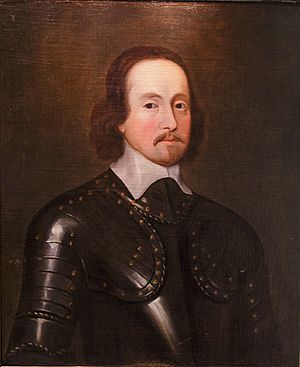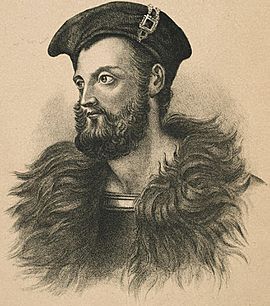Battle of Lisnagarvey facts for kids
Quick facts for kids Battle of Lisnagarvey |
|||||||
|---|---|---|---|---|---|---|---|
| Part of the Wars of the Three Kingdoms | |||||||
 Sir Charles Coote, Commonwealth commander in Northern Ulster |
|||||||
|
|||||||
| Belligerents | |||||||
| Commanders and leaders | |||||||
| Strength | |||||||
| c. 5,000 | c. 3,000 | ||||||
| Casualties and losses | |||||||
| c. 1,500 killed or captured | minimal | ||||||
The Battle of Lisnagarvey was a major fight on December 6, 1649. It happened near Lisnagarvey, which is now called Lisburn. This battle was part of the Irish Confederate Wars. These wars were linked to the bigger Wars of the Three Kingdoms (1638-1651).
In this battle, soldiers loyal to the Commonwealth of England won. They defeated an army that supported Charles II of England. This army was made up of Royalists and Scots Covenanters.
In early December, two Commonwealth leaders, Sir Charles Coote and Robert Venables, marched towards Carrickfergus. This was the only northern port not controlled by the Commonwealth. To stop them, Covenanter leader George Munro joined forces with Royalist Lord Clandeboye.
On December 6, the two armies met at Lisnagarvey. The Royalist-Covenanter army had more soldiers. But the Commonwealth forces were more experienced. Many Royalist soldiers ran away without fighting. Their retreat quickly became a complete defeat. Over 1,500 of their men were killed or captured.
Lord Clandeboye gave up soon after the battle. Carrickfergus surrendered on December 13. Munro escaped to Enniskillen. He returned to Scotland in early 1650.
Contents
Why the Battle Happened
The Irish Confederate Wars
The Irish Confederate Wars started with the 1641 Rebellion. At first, the fighting was between the mostly Catholic Confederation and a Protestant government army. This army was led by Ormond. Both sides said they were loyal to Charles I.
In Ulster, the northern part of Ireland, there was a three-sided war. It involved Royalists, Gaelic Catholic leader Eoghan Ó Néill, and Presbyterian soldiers. These Presbyterian soldiers were called the Laggan Army. They were helped by Scots Covenanters led by Robert Munro.
In 1643, Ormond made a truce with the Confederation. This truce was called the 'Cessation'. It allowed Ormond to send his soldiers to England. They fought against Parliament in the First English Civil War. Some Irish Protestants did not like this truce. They switched sides. One of them was Sir Charles Coote. He became a Parliamentarian commander.
Changes in Alliances
In 1649, the Confederation joined with Ormond's Royalists. This happened after Charles I was executed on January 30. The Laggan Army and Scottish troops in Ulster also joined them.
There were several reasons for these new alliances. The Covenanter government in Scotland did not trust Cromwell. He was a leader of the new Commonwealth of England. They thought he was a dangerous political and religious radical. They were also angry that the English had executed their king. As Presbyterians, they believed kings were chosen by God. So, they supported Charles I's son, Charles II of England.
However, the Confederation itself was divided. Some Catholic landowners wanted to keep things as they were in 1641. Others, like Ó Néill, had lost their lands in 1607. Because of this, Ó Néill made a truce with Coote. He refused to join the new alliance. This meant the alliance lost its strongest fighting force in the north. Even so, by July, Ormond's combined Royalist and Confederate army controlled most of Ireland.
Commonwealth Advances
In Ulster, Derry was the only major town still held by Commonwealth forces. Coote commanded the soldiers there. The Laggan Army, led by George Munro, surrounded Derry. But in July, Ó Néill forced Munro to end the siege. This showed how the truce between Coote and Ó Néill helped the Commonwealth.
Ormond's army was defeated at Rathmines on August 2. This allowed Cromwell and 12,000 soldiers to land in Dublin easily. After capturing Drogheda on September 11, Cromwell's main army went south. Colonel Robert Venables was sent north with about 2,500 men. His job was to take control of Ulster.
Munro's garrisons gave up quickly. By the end of September, Venables had taken Dundalk, Carlingford, Newry, and Belfast. Many Scottish settlers were forced to leave as punishment. When Coote captured Coleraine on September 15, he defeated the Scottish soldiers there.
The Battle of Lisnagarvey
At the end of October, Coote joined Venables in Belfast. They spent November taking over other Royalist strongholds in the north. In early December, they gathered 3,000 men. Their goal was to attack Carrickfergus.
After the siege of Derry was lifted, Munro had gone back to Enniskillen. He had the rest of the Laggan Army with him. Losing Carrickfergus would cut off communication with Scotland. So, Munro was determined to stop the Commonwealth forces.
Munro joined his soldiers with Royalist leader Lord Clandeboye. Together, they had about 5,000 men. However, this army was made of soldiers from many different groups. They were not well-equipped and felt discouraged. Most of them had not been paid in over two years. As they marched north, many soldiers left the army.
Coote and Venables learned about their advance. They moved to stop Munro. The first groups of soldiers met outside Lisnagarvey, near Lisburn, on December 6. The Royalists had more soldiers, but they could not stand against the Commonwealth army. The Commonwealth soldiers were much more experienced.
When the main Commonwealth army arrived, the Royalists' retreat quickly turned into a complete defeat. Most of them ran away without even firing their weapons. In the chase that followed, the Royalists lost 1,500 men. They were either killed or captured. They also lost their supplies and equipment. Clandeboye and the remaining soldiers surrendered soon after. Munro managed to escape to Enniskillen.
What Happened After
The Battle of Lisnagarvey ended the resistance of Scottish forces against the Parliamentarian army. Carrickfergus surrendered on December 13. Like other towns, its Scottish settlers were forced to leave.
In early 1650, Munro agreed to leave Enniskillen for £500. He then went back to Scotland. This left Ó Néill's army as the only major obstacle to Parliamentarian control in the north. However, Ó Néill had died in November 1649. This greatly hurt his army's morale and fighting ability. In June 1650, Coote and Venables defeated Ó Néill's army at Scarrifholis.
Sources


